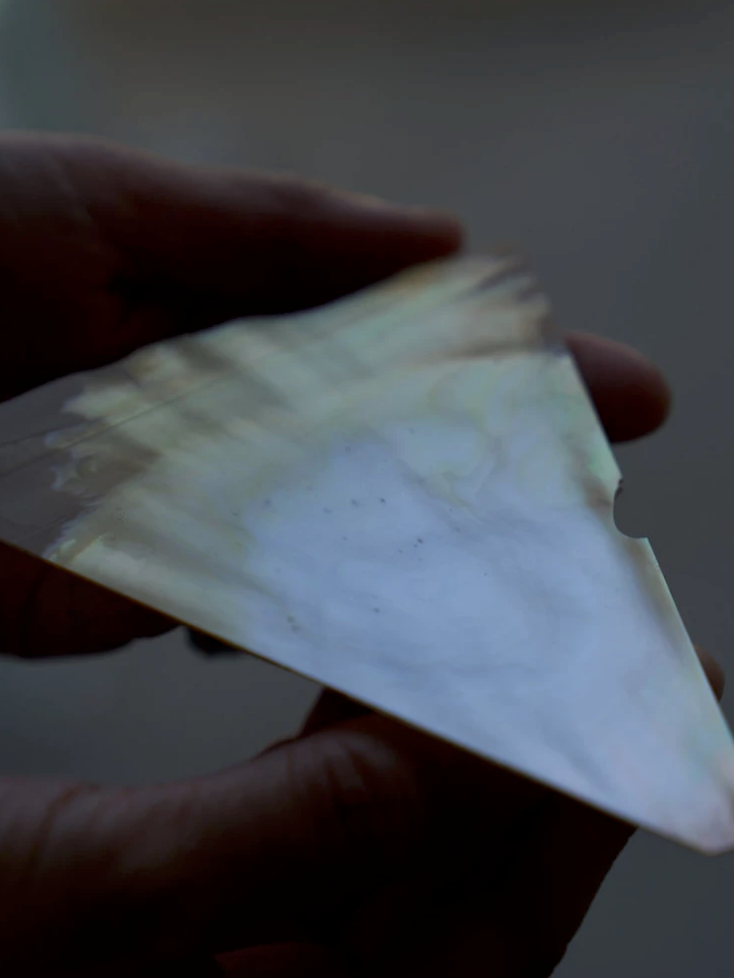Roots of mother-of-pearl that change into seven colors
2018.11.23
Glass, rattan, mother-of-pearl... SIRI SIRI jewelry is made from materials found in our daily lives. In the series "A Journey to Materials," we delve into perspectives that create new value while uncovering the origins and characteristics of materials.
-
Seven colors of mother-of-pearl that change constantly depending on the light and angle that comes in. Rare represents shellfish, and 鈿 means to be scattered. It is said that mother-of-pearl, a decorative technique in which shells are scattered, has been used mainly in traditional crafts such as lacquerware and obi. This technique is said to have been imported to Japan from China in the Nara period and became popular in the Edo period. Going back to around 3,000 BC, it was already used in the Mesopotamian civilization, and it is believed that it appeared in China during the Shang Dynasty, developed into an elaborate technique during the Song and Tang Dynasties, and spread to Japan and South Korea.
Mr. Yoshiki Matsuda, a maki-e artist who decorates SIRI SIRI's 'RADEN' collection, told me, ``In maki-e, the pasting of materials is called plain text.'' Makie is one of the techniques of lacquer art in which pictures, patterns, letters, etc. are drawn with lacquer on the surface of lacquerware, and metal powder is “sprinkled” before it dries. In addition to mother-of-pearl, cut gold is used to express gold, and egg shells are used to express pure white.

The types of shells used as materials for mother-of-pearl include white pearl oysters, abalone oysters, blue oysters, turban shells, and precious pearl oysters with good coloring. The 'RADEN' collection uses white pearl oysters, one of the pearl oysters. It features a translucent pearly luster and coloring. People say that they become shellfish when they keep their mouths shut and don't say anything. This is boiled in sea water for 3 or 4 days, and when it is thinly peeled off, a fairly thin mother-of-pearl sheet with a thickness of 0.1 mm is created.
Unchanging stubborn, yet fragile


Matsuda, a craftsman, describes mother-of-pearl, which is a living creature of nature, as “a stubborn person who never changes.” The mother-of-pearl itself is curved and difficult to blend in with, so it is necessary to apply it by pressing it down. “When I look at antiques displayed in museums, if lacquer and mother-of-pearl are mixed, the mother-of-pearl will always come off. The mother-of-pearl itself does not change over time. Although it is naturally strong, it is fragile and difficult to handle until it is "plaintext". This is because delicate shells that have become sheets of 0.1 mm are easy to break. It needs to be handled carefully and carefully by a craftsman, not by a machine. Because it is a fragile material, the spirit of "failure is inevitable" is required.
And the existence of lacquer is inseparable from mother-of-pearl. Lacquer, which is the sap collected from lacquer trees, is also an enzyme, so in a sense it can be said to be a living thing. In ordinary mother-of-pearl work, it is used as an adhesive. Adding color to the lacquer also has the effect of enhancing the coloring of the shell itself. “The hanging beehive is actually made of lacquer. Bees knew that the extract of the lacquer tree had an adhesive effect before humans did. You can also take the view that it was adopted as a result,” says Mr. Matsuda.

Raden sheets are carefully polished with water and sandpaper. It is a steady process of starting with a coarse-grained file and gradually changing to a fine-grained one. After polishing with sandpaper, it is further buffed with an abrasive to create a smooth mother-of-pearl sheet with no scratches. This process is indispensable for making the seven colors of mother-of-pearl shine beautifully. After lacquering only the surface to be fitted into the metal, Mr. Matsuda adjusts the mother-of-pearl sheet, which is laser-cut to match the shape of the metal, one by one with a file and fits it into the metal. Just as no single mother-of-pearl pattern is the same, the craftsman's skills are used to match the slightly different characteristics.
Mother-of-pearl is truly an ornament made of lacquer made from sea shells and forest trees. A top-class tribute that is found in nature and created by overcoming many failures by generations of craftsmen. Behind the unchanging brilliance lies the grand and micro story of the craftsmen.
Written by Tomoko Ogawa
Photo Go Itami


